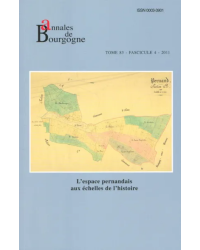- Unavailable



Dive into the fascinating history of the Pernand-Vergelesses vineyard with this book published in the Annales de Bourgogne. This volume explores the multiple facets of the Pernand area, from its commercial identity to its land evolution. An essential book for wine enthusiasts and local history buffs, offering a unique perspective on the AOC and the viticultural practices of the region.
Visa, MasterCard, Amex, Paypal or 3 times, interest-free with Scalapay

0.01€ from 35€ of purchase in France and from 99€ throughout Europe

Delivery in France and around the world at home, at office or in a pickup point

The Pernand Space through the Scales of History is an essential work for anyone interested in the viticultural history of Burgundy, particularly that of Pernand-Vergelesses. Published in the Annals of Burgundy (Volume 332, Tome 83, Issue 4), this book brings together contributions from recognized researchers exploring the various dimensions of this unique wine-growing area.
This volume, published in March 2012, offers an in-depth perspective on the historical, social, and viticultural evolution of Pernand-Vergelesses, a village at the heart of Burgundy. The book is illustrated by a hierarchical cadastral map of the vineyards of Pernand-Vergelesses created in 1861 by the Beaune Agriculture and Côte-d'Or Viticulture Committee. This document, preserved in the municipal archives of Beaune, provides valuable insight into the land structuring of the vineyard at that time.
Vincent Chambarlhac opens the volume with a reflection entitled This is Not a Monograph (pp. 357-362), where he questions the very nature of the work, emphasizing the importance of a multidisciplinary approach to understanding the Pernand space.
Christophe Lucand, for his part, offers a study on The Pernand Space, Between Commercial Identity and Land Singularity (pp. 363-376). This chapter highlights the evolution of the Pernand-Vergelesses vineyard, both in its commercial dimension and in its land organization, thus offering a nuanced understanding of the economic and social dynamics that have shaped this terroir.
In Les Copiaux, Jacques Copeau, in the Village - 1925-1929 (An Ongoing Investigation) (pp. 377-387), Vincent Chambarlhac explores the period when the famous director Jacques Copeau settled in Pernand-Vergelesses. This investigation sheds light on the impact of this iconic figure on the cultural and social life of the village during those years.
Thierry Hohl continues with a provocative study titled Pernand-Vergelesses: A Socialist Village? (pp. 389-408). He examines the political and social trends of the village, questioning the influence of socialism on the wine-growing community.
Florian Humbert addresses in The Pernand Space and the Issue of AOCs (pp. 409-424) the crucial role of Appellations of Controlled Origin in the structuring and promotion of Pernand-Vergelesses wines. This chapter is essential for understanding the evolution of viticultural practices and the recognition of terroirs.
Olivier Jacquet offers a detailed analysis of Collective Spaces in Pernand-Vergelesses and Identification of the Municipality's Wines (pp. 425-444). His study highlights the socialization places and their role in the identification and promotion of local wines.
Finally, Vincent Chambarlhac returns with Someone Passed Through There (Jacques Copeau's House in Pernand-Vergelesses around 1985) (pp. 445-455), where he traces the history of Jacques Copeau's house and its importance for local memory.
The volume concludes with a contribution from Serge Wolikow entitled A Research Program (2012-2014): Viticultural Burgundy: What History and What Future? (pp. 457-460). This chapter opens perspectives for the future of research on the viticultural history of Burgundy.
The Pernand Space through the Scales of History is a rich and varied work that appeals to both viticultural history specialists and wine enthusiasts eager to understand the historical roots of one of Burgundy's most prestigious vineyards. This book will allow you to delve into the historical, social, and land dynamics that have shaped the identity of Pernand-Vergelesses.
Data sheet